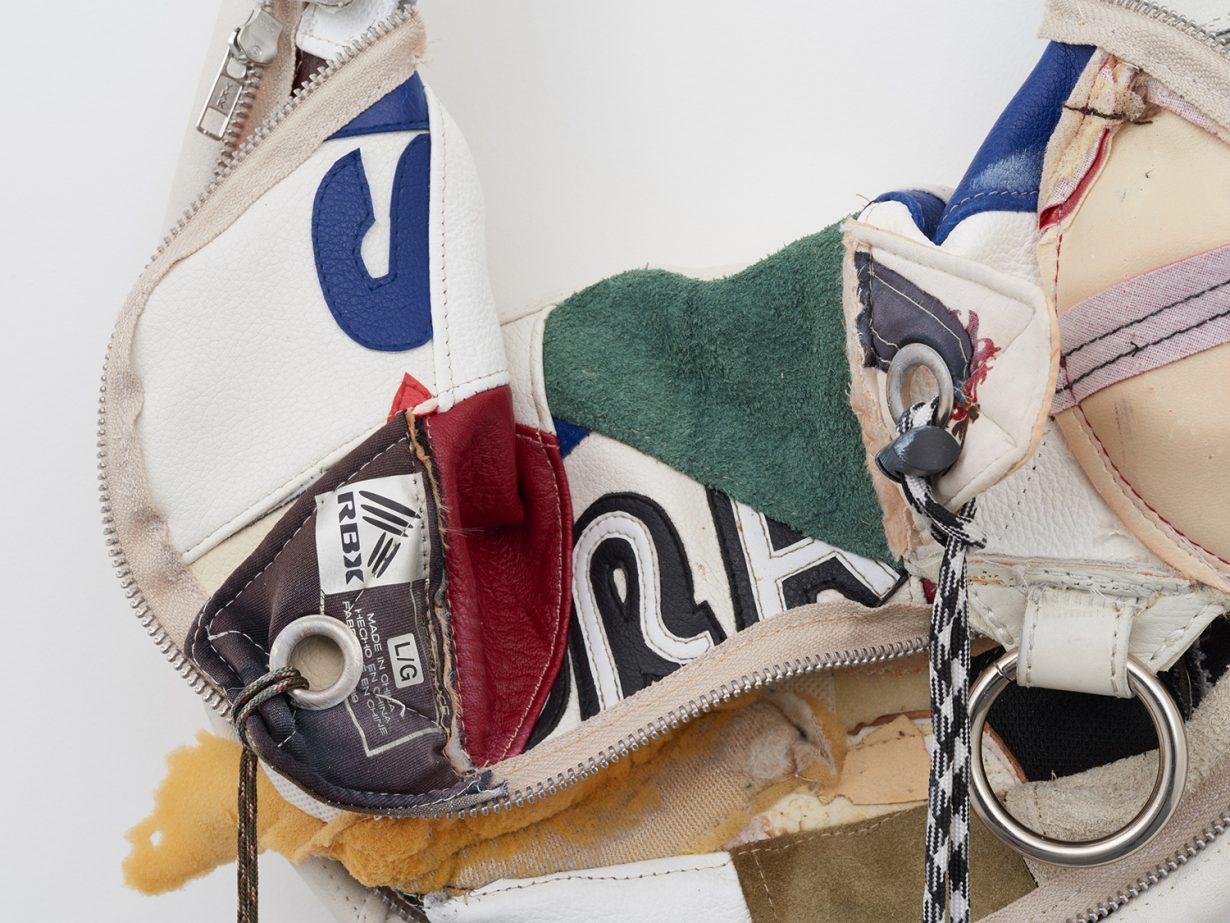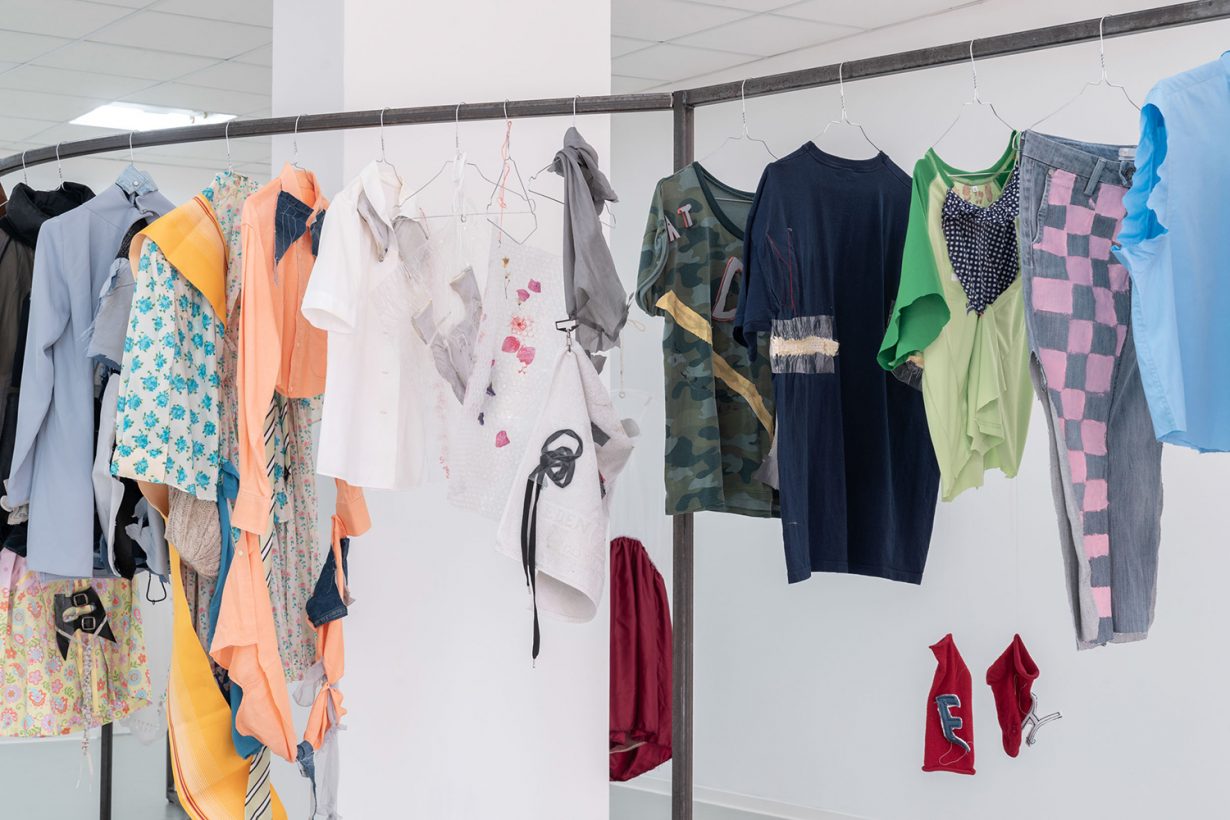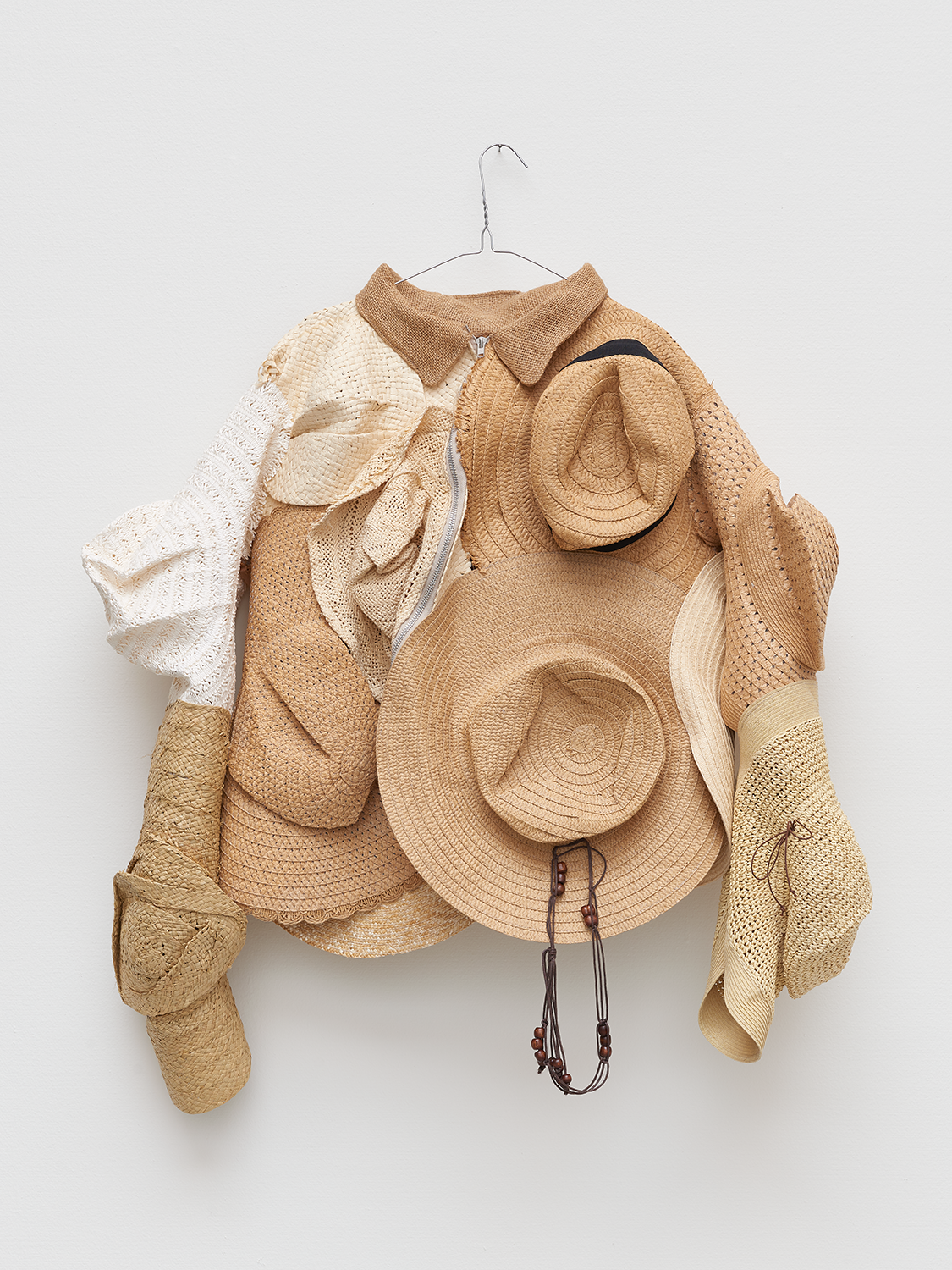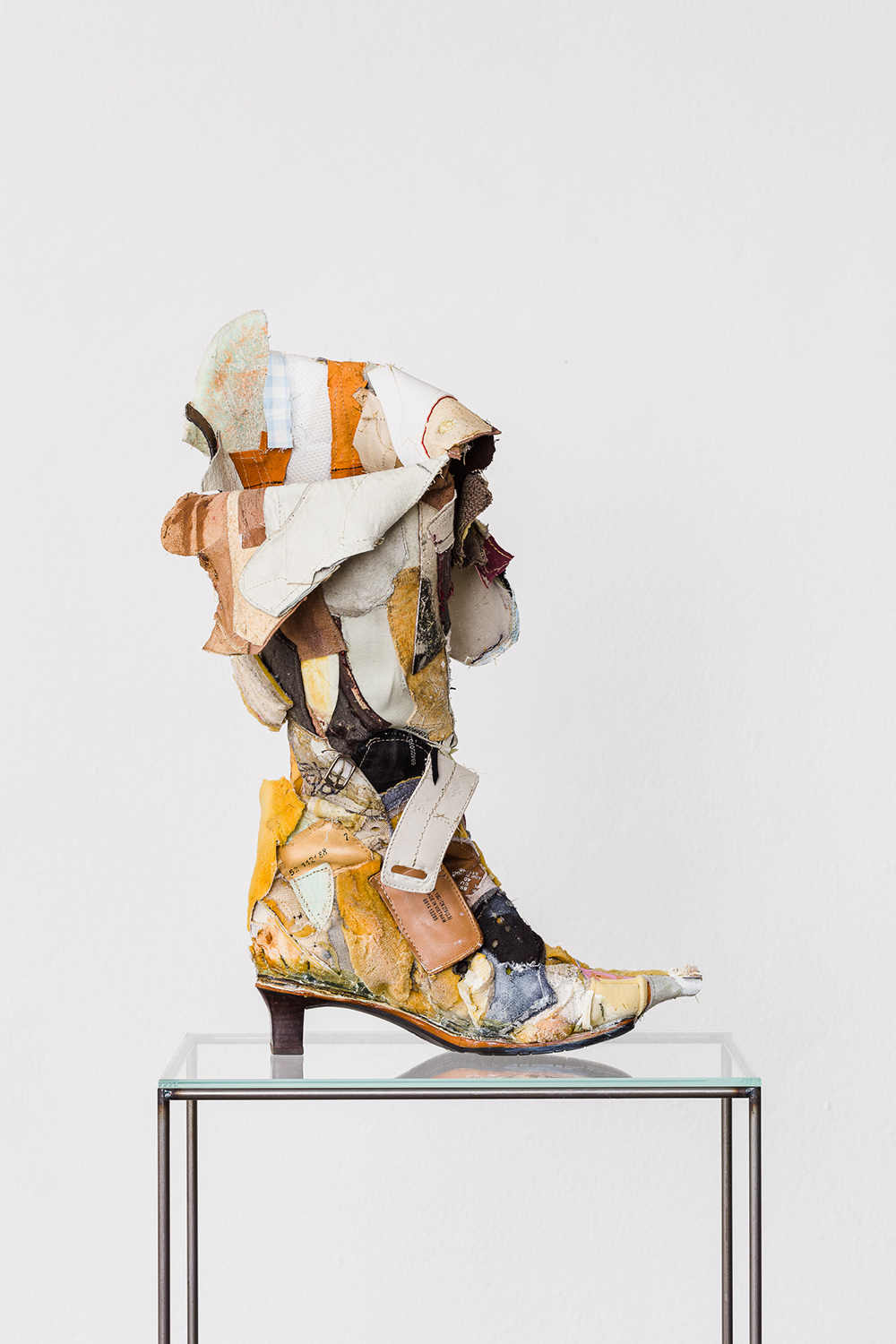The Dutch artist – who works in the space between sculpture and couture – on how garments can be provocative

Tenant of Culture is the moniker of Hendrickje Schimmel, a Dutch artist working in the space between sculpture and couture. Her objects are assembled with the flying tempo of fashion production, but these garments are clearly not factory made. The hand is visible inside every cut, stitch and rip. The work has been gripped and jammed into itself.
Schimmel’s objects range from near-functional clothing to collaged tapestries of ragged fabric. The garments are provocations, pointing towards radical futures, obscure historical movements and the strobing micro-trends of the current moment. The footwear is abstract; the hats are speculative and the tops dystopian. It’s all patched together from upcycled scraps, and when I imagine the culture that might grow up around these outfits, I am impressed by its vision and concerned for its quality of life.
Until 2016, Schimmel studied fashion and art in undergrad and graduate school, respectively. Now she occasionally works with public workshops, as a nod to the mechanics of clothing production, but behaves like a solitary artist, working in the studio and showing in galleries. She is, by her own declaration, not a designer.
In our conversation, conducted over video, Schimmel was kind and ebullient. She responded to each question with earnestness, energised by her own practice and by the flitting vicissitudes of culture.

Ross Simonini Where are you right now?
Tenant of Culture I’m in London. I’m originally from the Netherlands, but I’ve lived here on and off for about seven years.
RS Will you stay?
ToC I think my departure is coming closer and closer, actually. I always say, next year I’ll leave, and then I stay another year.
RS Where would you go?
ToC Belgium or Germany. Somewhere where living is a bit cheaper.
RS Why did you move to London?
ToC I did my masters here and obviously it’s a great city for fashion.
RS Would you say London was the centre of fashion at that time?
ToC When I was studying, the centre for fashion was definitely Paris. That’s where all the high-end fashion houses were. But London was more about street fashion and young labels.
RS Did you have the intention of working for a fashion house in school?
ToC No. I was never really looking to work for a big label. It’s funny that you say that, because the name of my practice actually makes a playful reference to the fashion house. You know, there’s lots of fashion houses that have Maison in their name.

RS Right, and your name suggests that culture is the house.
ToC It’s a bit of an open term, I borrowed it from [French historian and theorist] Michel de Certeau, who uses it as an allegory to reference the hierarchical relationship between producers and consumers. He uses that term to address the tactics that consumers employ to go against the strategies of producers through the misuse and reinterpretation of mass-produced goods. So it refers to that, but also to how lots of designers have a brand name, whereas in art it’s more common to use your own name.
RS You speak about theory often. Is your work grounded in theory?
ToC Theory is important to my practice, but when I make, it’s not theoretical at all. They exist separately. I mean, there’s an exchange, of course, but I always really depart from the materiality of a garment and see what journey that takes me on. I start from the concrete object. I open the seams, read the labels. It’s a very tactile and multisensory process. My work should speak for itself visually, without theory.
RS Do you research much?
ToC Yeah, definitely. I’m always reading. I read a lot of fashion magazines as well. Recently I’ve mostly been researching the industrial history of the fast-fashion industry, and how this relates to globalised supply chains.
RS I’ve noticed that it seems near impossible to find clothing made in ethical ways.
ToC Yeah, it’s really virtually impossible. And I think working up against that impossibility is also what I try to do in my work, by using postconsumer waste from the industry. A lot of brands currently present themselves as ethical, but there are so many different ways in which you can be ethical. Like as a brand you can be environmentally aware but not have ethical labour practices, for example. There’s such a highly developed division of labour within the fashion industry, through subcontracting and globally scattered assembly lines, it’s really hard to track where and under what conditions something is made.

RS How do you deal with this in your own clothes?
ToC I make a lot of my own clothes, which is very fun to do. I also upcycle a lot of garments. I like doing little tweaks to a garment to personalise it. I use the same methods that I use to construct my work. It becomes a bit of a blur, and sometimes I wear pieces that I was going to use for my work as well. It’s a real exchange.
RS Do you tend towards any particular personal style?
ToC That’s a good question. I don’t think I have one style. Sometimes it’s business casual, sometimes it’s sporty [laughs]. I enjoy following trends to try and understand why they emerged and identify with them on a personal level.
RS Are there any trends that you’re tracking right now?
ToC I’ve always been interested in trends that employ a sense of pastoral nostalgia in one way or another, like the hiking gear trend, worn in a city environment, which entirely defies its utilitarian nature and instead becomes decorative. I’m intrigued by fashion trends that are very contradictory in the way they sit in the cultural landscape they operate in. Like, the mini-bag trend.
RS When you look at these trends, do you think about them in a sociological sense? Like, what does the mini-bag trend say about people?
ToC I’m interested in fashion’s semiotics, for sure. It’s an interesting dynamic, because as a phenomenon fashion is designed to escape analysis. A trend disappears as soon as you’re able to identify it as such, because for exactly this reason it has already lost its pull. People desire what they can’t grasp yet.

RS Fashion trends seem to move more quickly than art trends.
ToC Well, essentially fashion is the very definition of change.
RS While art often aims to create something timeless…
ToC Fashion acknowledges its own instability and employs that as a system. But somehow the idea of trendiness is looked down upon in art, which is concerned with autonomy and the individual genius.
RS In the future, do you think your current work will look very 2022?
ToC I think it’s interesting to make things that look very current, and see how they age and what happens to their perception later on. That’s what fashion can do. When you look back at what you were wearing, you could really cringe, and then later on you can be like, actually that was kind of a sick outfit. It is cyclical.
RS What would be the closest thing to timelessness in fashion? Is there some kind of garment that you think hasn’t been affected that much over time?
ToC Maybe the white sneaker. Since its invention, it’s been an absolute staple. There are other iconic garments, too, like a beige trench coat, blue jeans, white T-shirts and black leather jackets, which never change much, but I wouldn’t say there’s a garment that escapes time altogether.
RS Socks?
ToC Yeah. Maybe because they’re not as visible. Though I walked past a shop today that sells only socks: all colours, materials, shapes. I saw a bunch of police officers in there looking at socks.

RS I often base clothing choices on the feeling of the material. Do you?
ToC Yes. Synthetic clothing makes me feel really sweaty and trapped in it, if it’s for example 100 percent viscose. So I check labels. I used to be able to wear almost anything as long as it looked good, but I’ve given up on that.
RS Do you identify yourself through what you wear?
ToC Yeah, absolutely. Everyone has to dress themselves in the morning, which is very much an intentional, sometimes even strategic act, and you can’t escape it. So when somebody says, oh, I really don’t care about what I wear, you know, that’s still a choice in a way. That’s why, when I show work, everyone has a very personalised opinion on it.
RS Can you give an example of an article of clothing that expresses identity for you?
ToC Perhaps the chore jacket. Inspired by the French farmhand’s jacket, cotton, with four pockets on the front and a flat collar, straight cut, not much shape in it. It’s currently popular among creative people here in London, often in indigo blue. It is usually artificially faded as well, as if bleached by hard work in the sun. It’s very interesting to think about what that jacket communicates, because essentially it’s appropriating the clothing of the rural working class. And why would you wear that in a city environment when you probably work behind a computer? The jacket effectively communicates a kind of indifference towards fashion and a sense of uniformity, but actually is extremely specific from a design perspective.

RS When you make an object or garment, are you taking its demographic into consideration? For example, the jacket that you made out of straw hats…
ToC Definitely. I was interested in the appropriation of rural working-class dress in the cottagecore phase that was very evident on social media at that time. One aspect of this was the reemergence of the milkmaid look, which included straw hats and frilly tops with a bit of shoulder showing. It’s so heavily nostalgic. I found a book on this by Meredith Martin called Dairy Queens: The Politics of Pastoral Architecture from Catherine de’ Medici to Marie-Antoinette. This book is about how historically, in the French courts from the sixteenth century onwards, the dress of milkmaids was employed to make women of the nobility who weren’t able to conceive or who were disobedient to appear more fertile and virtuous. They commissioned dairy follies for the women, where they would act out this pastoral play, which was entirely for the purpose of restoring their reputation.
RS You often consider class in your work. Were you raised in a way to be made aware of class?
ToC Well, I think fashion relates very much to class and hierarchies, and I come from a very long line of Dutch farmers, so perhaps that explains the interest in rural dress.
RS You seem very productive to me. Does it feel this way to you?
ToC I can work quite fast, materially. That’s my fashion background. The speed of production is very different in a fashion context than in an art context, and that also determines what my work looks like. It is only the making process in which I make quick decisions, the research and material sourcing takes much longer.
RS How much of what you make do you show?
ToC A small percentage. I make a lot of textiles rather than sculptural pieces. I was trained to work this way when I studied textiles, to make a lot of samples. So I have a pile of reject samples, which I often reincorporate into other pieces. I also de-assemble a lot of work and remake it even after I’ve shown it.

RS Is your studio filled with clothing?
ToC Yeah definitely, it’s like a carpet of discarded and secondhand clothing, an environment of endless piles of materials. I go to my studio to be in that chaos. Everything is just spread out over the floor or in open shelving. So I have my eye on everything. And the process is almost like felting. Things meet each other on the floor of my studio, and they form this kind of visually interesting moment.
RS When you conduct workshops, how much of the work is being made by you and how much of it is made in a collaborative fashion?
ToC Yes, I host workshops where we re- and upcycle discarded clothing. This is something that I’m really experimenting with at the moment. I have done workshops where people made their own pieces and it’s their work.
In other workshops we collaborate on pieces. I always wanted to be part of a collective experience of making. Which is also where the notion of the fashion house comes from historically: the concept of in-house production. Everything was made in-house, from the design to the execution, it was all done collaboratively under one roof. That is a bygone era, pre-division of labour. But I do think the principle of that can be very interesting.
I don’t think I would ever actually start a fashion brand, though.
RS Do you sew by hand or use machines?
ToC Mostly machines. I had quite a technical education and I have a few industrial sewing machines that I often use, that stitch through the thickest of fabrics. I also use a heat press.
I look at how a garment is produced and try to recreate that production method, to gain insight into its method of assembly. I’m not patient enough for hand sewing.
RS Since we discussed trends, do you see your art as a part of a trend of what’s going on in the artworld?
ToC I think, yes, absolutely. There are a lot of garments and fashion references in contemporary art these days. And I think perhaps that is because fashion is very interesting and worth examining as a phenomenon as well as an industry, but within the fashion world itself there is not much space or time to reflect on it.
RS Why do you think art and clothing are coming together in this way now?
ToC I think what we have to reckon with at the moment is overproduction, and fashion is one of the driving factors behind overproduction, because it is the instigator of stylistic newness. Capitalism relies heavily on the system of fashion to always create a desire for something new. It is important that we collectively reflect upon this, and I think you can achieve this through the re-contextualisation of garments in an art context. Art obscures all this industrial reality more, where with fashion you can see it on everyone you meet.
From the March 2022 issue of ArtReview